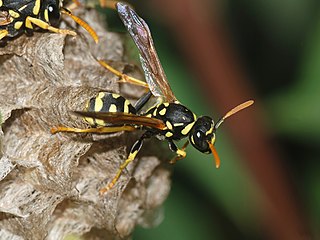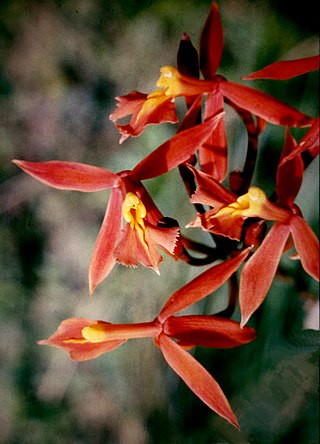
Hemichordata is a phylum which consists of triploblastic, eucoelomate, and bilaterally symmetrical marine deuterostome animals, generally considered the sister group of the echinoderms. They appear in the Lower or Middle Cambrian and include two main classes: Enteropneusta, and Pterobranchia. A third class, Planctosphaeroidea, is known only from the larva of a single species, Planctosphaera pelagica. The class Graptolithina, formerly considered extinct, is now placed within the pterobranchs, represented by a single living genus Rhabdopleura.

A cockatoo is any of the 21 species of parrots belonging to the family Cacatuidae, the only family in the superfamily Cacatuoidea. Along with the Psittacoidea and the Strigopoidea, they make up the order Psittaciformes. The family has a mainly Australasian distribution, ranging from the Philippines and the eastern Indonesian islands of Wallacea to New Guinea, the Solomon Islands and Australia.

Hydrosaurus, commonly known as the sailfin dragons or sailfin lizards, is a genus in the family Agamidae. These relatively large lizards are named after the sail-like structure on their tails. They are native to Indonesia and the Philippines where they are generally found near water, such as rivers and mangrove. Sailfin lizards are semiaquatic and able to run short distances across water using both their feet and tail for support, similar to the basilisks. They are threatened by both habitat loss and overcollection for the wild animal trade.

Polistes is a cosmopolitan genus of paper wasps and the only genus in the tribe Polistini. Vernacular names for the genus include umbrella wasps, coined by Walter Ebeling in 1975 to distinguish it from other types of paper wasp, in reference to the form of their nests, and umbrella paper wasps. Polistes is the single largest genus within the family Vespidae, with over 200 recognized species. Their innate preferences for nest-building sites leads them to commonly build nests on human habitation, where they can be very unwelcome; although generally not aggressive, they can be provoked into defending their nests. All species are predatory, and they may consume large numbers of caterpillars, in which respect they are generally considered beneficial.

The Oncidiinae is a subtribe within the Orchidaceae that consists of a number of genera that are closely related.

Epidendroideae is a subfamily of plants in the orchid family, Orchidaceae. Epidendroideae is larger than all the other orchid subfamilies together, comprising more than 15,000 species in 576 genera. Most epidendroid orchids are tropical epiphytes, typically with pseudobulbs. There are, however, some terrestrials such as Epipactis and even a few myco-heterotrophs, which are parasitic upon mycorrhizal fungi.

Rhopalostylis is a genus of two species of palms native to the South Pacific. Both are smooth-trunked, with regular ringed scars from fallen leaves. The leaves are 3–5 m in length, and the leaf bases encircle the trunk.

Rhopalosomatidae is a family of Hymenoptera containing about 68 extant species in four genera that are found worldwide. Three fossil genera are known.

Ouranopithecus is a genus of extinct Eurasian great ape represented by two species, Ouranopithecus macedoniensis, a late Miocene hominoid from Greece and Ouranopithecus turkae, also from the late Miocene of Turkey.

Spiranthes is a genus of orchids in the subfamily Orchidoideae. They are known commonly as ladies tresses, ladies'-tresses, or lady's tresses. The genus is distributed in the Americas, Eurasia, and Australia. The genus name Spiranthes is derived from the Greek speira ("coil") and anthos ("flower"), and was inspired by the spirally arranged inflorescence.

Pipunculidae is a family of flies (Diptera) commonly termed big-headed flies, a reference to the large (holoptic) eyes, which cover nearly the entire head. The family is found worldwide and more than 1300 species have been described.

Baiomys is a genus for the New World pygmy mice. Together with Scotinomys, it forms the tribe Baiomyini. It contains the smallest rodents in North America. It currently contains three extant species:

Indopithecus giganteus is an extinct species of large ape that lived in the late Miocene of the Siwalik Hills in northern India. Although frequently assigned to the more well-known genus Gigantopithecus, recent authors consider it to be a distinct genus in its own right.

The Ceratobatrachidae are a family of frogs found in the Malay Peninsula, Borneo, the Philippines, Palau, Fiji, New Guinea, and the Admiralty, Bismarck, and Solomon Islands.

Saccoglossus is a genus of acorn worm. It is the largest genus in the Enteropneusta class, with 20 species.

An anchovy is a small, common forage fish of the family Engraulidae. Most species are found in marine waters, but several will enter brackish water, and some in South America are restricted to fresh water.

Heteropoda davidbowie is a species of huntsman spider of the genus Heteropoda. It was described from the Cameron Highlands District in peninsular Malaysia and named in honour of singer David Bowie.

Dendrobieae is a tribe in the subfamily Epidendroideae, in the family Orchidaceae. The Dendrobieae are mostly tropical, epiphytic orchids which contain pseudobulbs.
Liopteridae is a family of wood-boring parasitoid wasps. They occur worldwide with concentrations in the African Tropics. These insects have a petiolate abdomen. There are 10 genera and more than 140 species known.

This timeline of stegosaur research is a chronological listing of events in the history of paleontology focused on the stegosaurs, the iconic plate-backed, spike-tailed herbivorous eurypod dinosaurs that predominated during the Jurassic period. The first scientifically documented stegosaur remains were recovered from Early Cretaceous strata in England during the mid-19th century. However, they would not be recognized as a distinct group of dinosaurs until Othniel Charles Marsh described the new genus and species Stegosaurus armatus in 1877, which he regarded as the founding member of the Stegosauria. This new taxon originally included all armored dinosaurs. It was not until 1927 that Alfred Sherwood Romer implemented the modern use of the name Stegosauria as specifically pertaining to the plate-backed and spike-tailed dinosaurs.


















